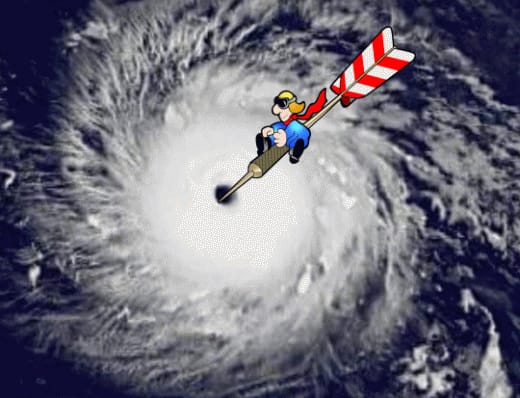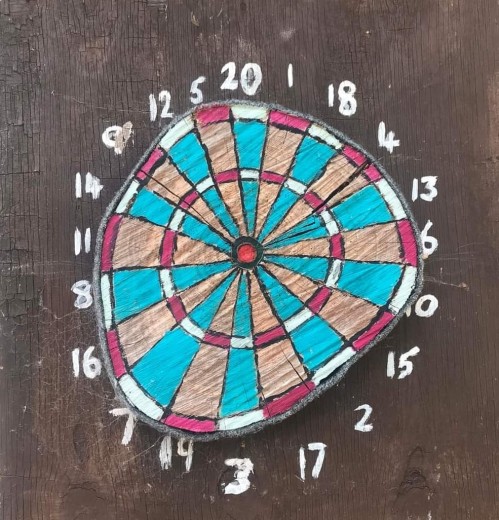Friday, September 1, 2017
Column 543
Trillions of gallons, darts, and a lapdance
When I learned that Hurricane Harvey has, so far, dumped NINE TRILLON GALLONS of rain on Texas and surrounding areas I was reminded of an article by Jacqueline Leo in The Fiscal Times that caught my eye a while back.
Don’t ask me what I was doing reading The Fiscal Times.
Most of us, wrote Leo, can’t imagine the scope or volume of a million anything, let alone a trillion. For example, if you were to try to imagine 40 trillion gallons of water, you’d probably be at sea, so to speak. But if I told you that 39.75 trillion gallons of water fills Lake Tahoe, you’d have a pretty good idea of the volume. Another puzzler: How many pennies would fill the Empire State Building, including the stairwells and elevator shafts? One estimate comes up with 1,818,624,000,000.
Since it comes up so often in talk about the nation’s finances, we decided to demystify the idea of a trillion. (Here are) some surprising ways you can explain this gigantic number to your family and friends.
How far back would you have to go? A trillion seconds ago, it was 29,701 BC and Neanderthals had just left the scene, leaving the planet to our ancestors.
It would take the 26,000 trees in Central Park 769 years to produce a trillion leaves.
If you work 40 hours a week, you would have to make $480,769,231 per hour to earn $1 trillion in a year.
For just a little bit more than $1 trillion in the 1940s, America could have fought World War II four times over.
With an average stride length of 30 inches, you would need to walk 473,484,848 miles, a distance equal to 19,015 trips around the globe – or one trip to Jupiter when it’s in opposition – and still have enough steps left over to walk to Mars three times before you hit a trillion. But bring an extra pair of sneakers; at an average walking speed of four miles per hour, it would take you 28,538,813 years to walk that far.
Laid end to end, a trillion dollar bills would stretch 96,906,566 miles, more than enough distance to reach the sun.
If every U.S. service member ate 2,500 calories a day while deployed to Iraq, it would take until next year before they will have consumed a trillion calories.
If you put the entire human population on a scale, their total weight would be about a trillion pounds.
One trillion bricks are enough to build the Great Wall of China 258 times, or long enough for the wall to reach the moon and back, twice.
Naturally, this got me thinking about darts…
So I contacted a couple of math-wonk buddies and put them to work.
To paraphrase Leo, here’s some surprising ways you can explain this gigantic number to your darts family and friends.
If you throw three darts every 10 seconds, you would need to throw darts for 105,699 years to throw one trillion darts. You would have to walk about 992 million miles (roughly the distance from the Sun to Saturn).
If a trillion darts were shared equally by the world’s human population, each person would have about 150 darts.
If a trillion darts in a tight grouping each make a separate hole of area 1 square (round) millimeter the combined area of the trillion holes would be 1 square kilometer and would completely cover Delft, Netherlands; Chester, UK; the Old City of Jerusalem; or Rio de Los Angeles State Park in California.
If, as in the old days, a dart had three turkey feathers and an average turkey has 3,500 feathers (they do according to Google), 857,142,857 turkeys would need to be plucked to equip one trillion darts. It would require all the turkeys eaten each Thanksgiving in America (45 million) for 19 years to feather one trillion darts.
At an average weight of 23 grams, one trillion darts would weigh close to 53 billion pounds – more than six times the weight of the Great Pyramid of Giza. Throwing one trillion darts would be the equivalent of lifting 71,428,572 people – more than the entire population of England.
If lined up point to flight one trillion darts would stretch approximately 3,288,089 miles, or 132 times around the equator of the earth.
Assuming you scored 180 in every trip to the line, it would take you 555,555,556 trips to the line to score one trillion points.
If you were to drink three 12-ounce bottles of beer every day over the period of throwing a trillion darts, you would drink 1,085,000 gallons of beer, the equivalent of almost two Olympic-sized swimming pools and about the same amount of water the average American family uses, indoors and outside, in ten years. At $2.50 per beer, you would spend approximately $3.5 billion, enough to purchase two Trident submarines or 7,000 homes for $500,000 each or to foot the cost of paying six years’ earnings for 56,561 minimum-wage workers.
If you bought one gallon of gasoline every day over the period of throwing a trillion darts, you would be able to drive 964,506,113 miles, or 38,733 times around the circumference of the Earth. At $3.50 per gallon, you would spend $135,030,855 dollars, enough to buy 50 Super Bowl ads; Dracula’s castle in Romania; 135 McDonald’s franchises…
…or (if you’re Scott Wollaston and at $100 each) a lap dance a day for 36,986 years.
From the Field,
Dartoid








